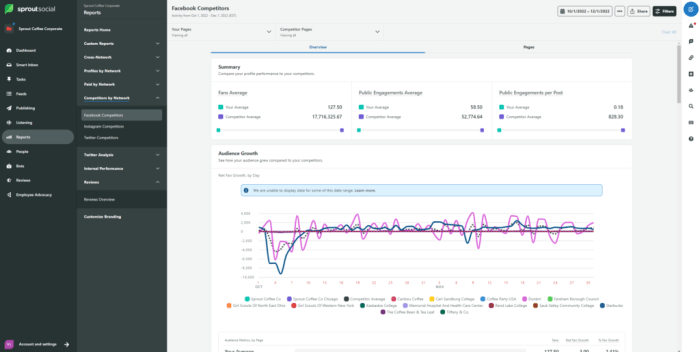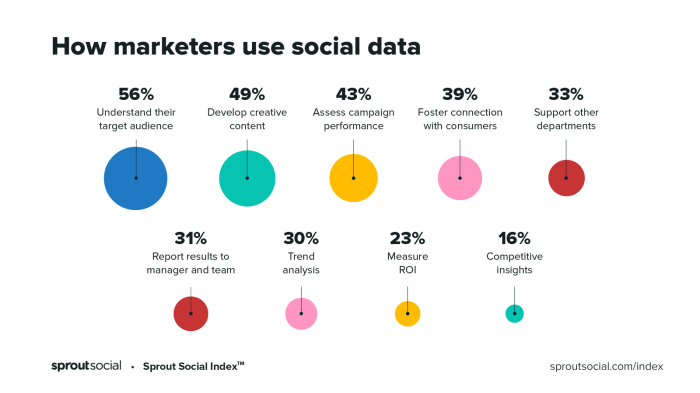Using Social Media Analytics for Strategy opens up a world of possibilities, where businesses can harness the insights from data to revolutionize their marketing game. Dive into this realm of analytics and discover the untapped potential waiting to be explored.
From understanding key metrics to tracking competitor performance, this topic delves deep into the realm of social media analytics and its pivotal role in shaping effective marketing strategies.
Understanding Social Media Analytics
Social media analytics involves collecting, analyzing, and interpreting data from social media platforms to make informed decisions and strategies. By examining metrics such as likes, shares, comments, and engagement rates, businesses can gain valuable insights into their audience’s behavior and preferences.
Examples of Data Analyzed
- Number of likes, shares, and comments on posts
- Engagement rates and reach of content
- Demographic information of followers
- Click-through rates on links
Importance in Marketing Strategies
Social media analytics plays a crucial role in developing effective marketing strategies. By analyzing data, businesses can tailor their content to better resonate with their target audience, identify trends and patterns to optimize campaigns, and measure the impact of their efforts. This data-driven approach helps businesses make informed decisions and maximize their ROI in social media marketing.
Tools for Social Media Analytics

Social media analytics tools are essential for businesses to track their online performance and engagement with their audience. These tools provide valuable insights into how well a business is doing on social media platforms, helping them make informed decisions and improve their strategies.
Popular Tools for Social Media Analytics
- Sprout Social: Offers in-depth analytics, social listening, and reporting tools to track engagement and monitor brand mentions.
- Hootsuite: Allows users to schedule posts, monitor conversations, and analyze performance across multiple social media platforms.
- Google Analytics: Provides detailed data on website traffic, referral sources, and user behavior from social media platforms.
- Buffer: Helps businesses schedule posts, analyze performance, and track engagement on social media channels.
Comparing Features of Different Social Media Analytics Tools
- Sprout Social offers comprehensive reporting and social listening features, while Hootsuite focuses more on scheduling and publishing content.
- Google Analytics provides a wider range of data beyond social media metrics, making it a powerful tool for overall website performance analysis.
- Buffer is user-friendly and great for small businesses looking to manage their social media presence efficiently.
Leveraging Social Media Analytics Tools for Business Insights
- Businesses can use these tools to track key performance metrics, such as engagement rates, audience demographics, and content reach.
- By analyzing these data points, businesses can identify trends, optimize their social media content, and tailor their strategies to better resonate with their target audience.
- Social media analytics tools also help businesses track the effectiveness of their campaigns, measure ROI, and make data-driven decisions to improve their overall online presence.
Key Metrics to Track

Tracking key metrics is essential when analyzing social media data to measure the success of your strategies and campaigns. Understanding these metrics can help you make informed decisions and optimize your social media efforts for better results.
Engagement Rate
Engagement rate is a crucial metric that measures how actively involved your audience is with your content. It includes likes, comments, shares, and other interactions. A high engagement rate indicates that your content is resonating with your audience, leading to increased brand awareness and loyalty.
Reach
Reach refers to the total number of unique users who have seen your content. It helps you understand the potential impact of your posts and how many people are exposed to your brand. Increasing reach can expand your audience and attract new followers or customers to your brand.
Impressions
Impressions represent the total number of times your content has been displayed on users’ screens. While similar to reach, impressions focus on the frequency of exposure rather than unique users. By tracking impressions, you can evaluate the visibility of your content and optimize your targeting strategies to reach a larger audience.
Click-Through Rate (CTR)
CTR measures the percentage of users who clicked on a link in your post compared to the total number of users who saw it. A high CTR indicates that your content is compelling and driving traffic to your website or landing page. Monitoring CTR can help you identify the effectiveness of your call-to-action and optimize your content for better performance.
Conversion Rate
Conversion rate measures the percentage of users who completed a desired action, such as making a purchase or signing up for a newsletter, after interacting with your social media content. A high conversion rate indicates that your content is persuasive and driving valuable actions. Tracking conversion rate can help you assess the impact of your social media campaigns on your business goals.
Using Social Media Analytics for Target Audience Analysis: Using Social Media Analytics For Strategy
Understanding your target audience is crucial for businesses to create effective marketing strategies. Social media analytics can provide valuable insights into the demographics of your audience, helping you tailor your content to better resonate with them.
Utilizing Demographic Insights
- By analyzing social media data, businesses can gather information on the age, gender, location, and interests of their followers.
- This data can help businesses create targeted campaigns that appeal to specific demographics, increasing engagement and conversion rates.
- For example, a clothing brand targeting young adults can use social media analytics to identify the preferred fashion trends among that age group and tailor their content accordingly.
Segmentation and Targeting Strategies, Using Social Media Analytics for Strategy
- Social media analytics enable businesses to segment their audience based on various criteria, such as behavior or purchasing patterns.
- By identifying different audience segments, businesses can create personalized content that speaks directly to the needs and preferences of each group.
- For instance, a tech company can use social media analytics to target different segments of their audience with specific product offerings based on their online interactions.
Monitoring Competitor Performance
Social media analytics can play a crucial role in monitoring competitor performance by providing insights into their online activities, engagement levels, and audience demographics. By tracking key metrics such as follower growth, engagement rates, and content performance, businesses can gain valuable information about how their competitors are performing on social media platforms.
Benchmarking Against Competitors
- Compare follower growth: Analyzing the rate at which competitors are gaining followers can help businesses understand their relative popularity and reach on social media.
- Evaluate engagement levels: Monitoring likes, comments, and shares on competitors’ posts can provide insights into the type of content that resonates with their audience.
- Analyze content performance: By examining the type of content that performs well for competitors, businesses can learn about trending topics and engagement strategies that work effectively.
Benefits of Competitor Analysis
- Identify industry trends: By monitoring competitors, businesses can stay informed about industry trends and adjust their own social media strategy accordingly.
- Improve strategy formulation: Understanding competitor performance can help businesses identify gaps in their own strategy and make informed decisions to enhance their online presence.
- Enhance audience targeting: By analyzing competitor audience demographics, businesses can refine their target audience and tailor their content to attract similar followers.












